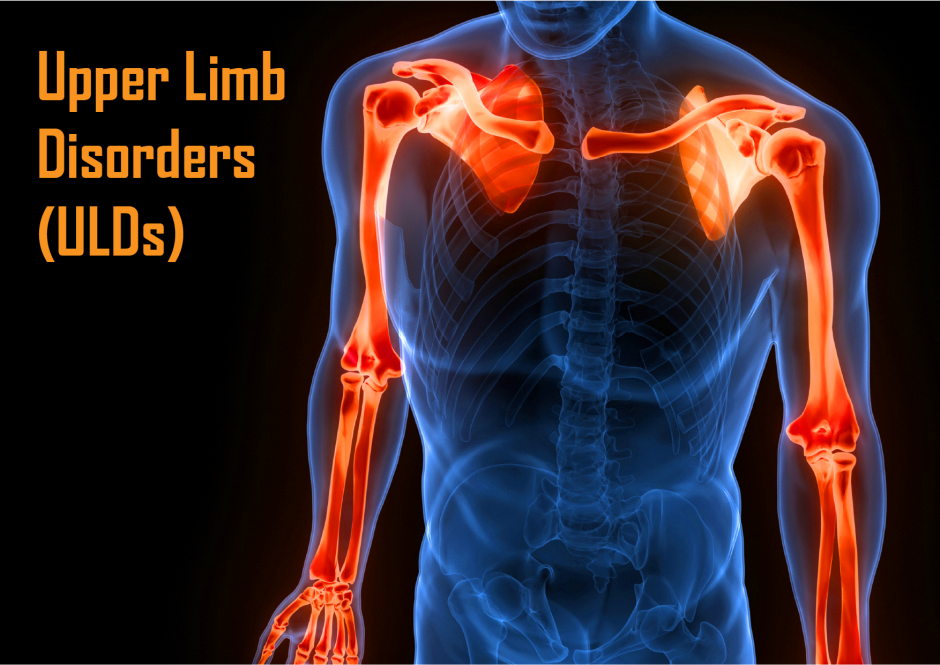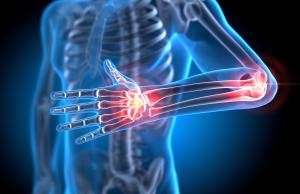
Introduction
The term upper limb disorders (ULDs) is an umbrella term used for a range of musculoskeletal conditions affecting the hand, wrist, arm, shoulder and neck. It covers those conditions, with specific medical diagnosis (for example, frozen shoulder, carpal tunnel syndrome, or hand-arm vibration syndrome - ‘HAVS’), and other conditions (for example, repetitive strain injury - ‘RSI’) where there is pain without specific symptoms.
ULDs can include problems with the soft tissues, muscles, tendons and ligaments, along the circulatory and nerve supply to the limb.
It should be noted that some specified work-related ULDs are reportable as required under the Reporting of Injuries, Diseases and Dangerous Occurrences Regulations (NI) 1997 (RIDDOR) (as amended by Reporting of Injuries, Diseases and Dangerous Occurrences (Amendment) Regulations (NI) 2004).
ULDs can occur in almost all workplaces and are usually preventable. However, high reporting levels of arm pain are known to be prevalent in the following worker groups:
- assembly line workers
- cleaning and domestic staff
- construction workers
- meat and poultry processors
- mushroom pickers
- secretaries/temps
- textile workers
Whilst not all ULDs are work-related, experience has shown that they are often caused or made worse by work.
Persons often fully recover from ULDs when recognised early and they receive the appropriate treatment.
Symptoms of ULDs
Symptoms of ULDs include stiffness or pain from joints and the inability to straighten or bend those joints, accompanied by temporary fatigue.
Other symptoms may be aches and pains, tenderness, tension, stiffness, weakness, tingling, numbness, cramp and swelling to any part of the arm from fingers to the shoulder or the neck.
These symptoms may suggest overuse or damage to the limb or some underlying condition.
If you are concerned, please speak to your doctor/GP.
Warning signs of ULD issues in the workplace
The following warning signs could be an indication of ULD issues in the workplace:
- injury and illness records
- jobs which employees are reluctant to do
- jobs where employees complain of discomfort
- employees having made adaptations to workstations, tools or chairs
- employees requesting to be re-deployed or taken off a job
- splints or bandages being worn, and/or
- use of painkillers when undertaking normal/routine tasks
Assessment of workplace ULD risks


Identification and risk assessment of the tasks associated with ULDs in the workplace are key steps to effectively manage work-related ULDs.
The employer and the workforce need to work together and adopt an ergonomic approach to identify, assess and control the risk of ULDs in the workplace.
Organisational changes do not necessarily need to be expensive. Simple and low-cost changes can often be effective, such as:
- tackle the serious risks or those that affect a large number of employees first
- consideration of the risks when setting up new workstations - it is cheaper than redesigning them or purchasing more suitable tools at a later stage
- try to make the task and workstation suitable for each worker, rather than make the worker adapt to fit the task and workstation
- try out any changes you make on one or two employees to see if they are effective before making changes for everyone
Reducing the risk of developing ULDs in the workplace
Senior management commitment is required to effectively manage ULDs in the workplace.
The presence of shared and interlinked organisational beliefs, attitudes and behaviours that facilitate the effective management of ULD risks is also required.
To develop a workplace environment capable of dealing with ULDs, the following key organisational features are essential:
- participation and involvement
- communication
- competence
- allocation of responsibilities
Reduce the impact of risk factors


Using an ergonomic approach, ULD risk factors can be considered as falling within three key areas - task, environment, and worker-related risk factors.
Employees may be more likely to suffer an upper limb problem if exposed to more than one risk factor.
However, it does not mean a worker will develop a ULD as a result of being exposed, or that ULD risks cannot be adequately controlled.
The main ULD risk factors and associate control strategies for each are as follows:
Task-related factor
Repetitive work:
Repetitive work requires the same muscle groups to be repeatedly used throughout the working day/shift which can result in issues such as muscle fatigue, metabolic waste material build up, and inflammation.
Examples of risk controls:
- assessment of repetitive tasks - the Health and Safety Executive’s (HSE) Assessment of Repetitive Tasks Tool (ART Tool) is designed to help assess repetitive tasks involving the upper limbs, it assesses some of the common risk factors in repetitive work that contribute to the development of ULDs
- automation of higher-risk tasks, however the potential for introducing new risks needs to also be considered
- break up work periods involving a lot of repetition with several short breaks instead of one break at lunchtime or mid-shift
- allow for short, frequent pauses for very intensive work
- reducing the task speed
Uncomfortable working postures:
Work which involves any movement of the arm, wrist and fingers into awkward or uncomfortable positions needs to be given appropriate consideration to prevent ULDs. For example, above shoulder or head height work, work whereby an employee has to bend their elbow significantly, or holding of any upper limb in the same position for extended periods.
Examples of risk controls:
- design workplaces and equipment for employees of different sizes, build, strength and also taking left-handed employees into consideration
- provide platforms, adjustable chairs and footrests, and tools with a suitable size grip
- arrange the position, height and layout of workstations to allow for comfortable reach whilst being suitable for the task
Sustained or excessive force:
Sustained or excessive force may be applied by employees for tasks which involve forceful pinching, gripping or manipulation of items, overcoming friction, or handling of heavy items/loads.
Examples of risk controls:
- automate tasks or provide suitable tools to reduce the force needed to be applied by employees
- provide mechanical aids/assistance, such as levers, jigs, supports, or counterbalance equipment, as deemed suitable for the task
- ensure any handles and/or controls that are used are well maintained and easy to manipulate without requiring the application of unnecessary force
- identification and provision of light weight tools/work equipment
- ensure all tools are well maintained and implement a regular maintenance policy
- ensure the right tools are used for the job which can reduce the amount of force required to perform tasks
- reduce item/load weight, or the distance moved or slide them instead of lifting
- introduce suitable job rotation to reduce worker exposure
Carrying out a task for a long period of time (exposure duration):
The risk of developing a ULD will increase when employees are exposed to ULD risks for an extended time period, for example, long shifts with limited scope for breaks and/or job rotation.
Examples of risk controls:
- rotating employees between sufficiently different high-risk tasks
- allow employees to undertake more than one step of a process (job enlargement) - this can reduce ULD risk exposure to one specific task (provided the steps do not have the same risks)
- introduce short frequent breaks for higher-risk activities (but not necessarily a rest)
- encourage stretching or other exercises during breaks/rest periods
Environment-related factors:
Vibration:
The risk of ULDs can increase because of vibrating work equipment and/or tools.
Examples of risk controls:
- carry out a hand-arm vibration (HAVS) assessment if employees are exposed to vibrating tools
- provision of efficient and low-vibration tools to reduce potential HAVS risks
- ensure appropriate maintenance of work equipment/tools to minimise vibration effects
- ensure sufficient availability of replacement low-vibration tools for when existing tools are no longer working properly
Poor working environment:
Working in uncomfortable temperatures or draughts and handling hot/cold items can result in decreased blood flow, sensation, dexterity, grip strength and increased muscle activity in the upper limbs.
Working in low lighting, shadows or glare may result in a worker adopting awkward positions and thus increase the risk of ULDs.
Examples of risk controls:
- where possible, reduce worker exposure to uncomfortable temperatures and put measures in place to maintain the workplace temperature at a comfortable level
- where a comfortable workplace temperature cannot be maintained, provide suitable personal protective equipment (PPE) and local heating or cooling as appropriate
- avoid putting workstations too near air vents
- ensure that lighting levels are sufficient or provide appropriate lighting for the task
- appropriately position lights and/or workstations and provide window blinds to avoid reflections and glare
Work Organisation (Psychosocial):
As well as considering the physical aspects of the work, psychosocial risk factors also need to be accounted for as they may affect employees’ psychological responses to their work and workplace conditions.
Examples include excessive workloads, tight deadlines and lack of control over the work and working methods.
Examples of risk controls:
- consult employees and their representatives on matters of health and safety and involve them in decisions about their work
- encourage teamwork and effective communication between employees and management
- rotate employees between tasks
- get the right balance for incentive schemes so that employees do not work beyond their natural limit - avoid schemes which create a culture of excessive work rates
- monitor work rates to keep the workload reasonable and to identify and address any excessive workloads
Worker-related factors
Individual differences and susceptibility:
Every person is different in terms of body size, age, ability or health. Some employees may also have underlying conditions and/or disabilities which need to be considered when they are requested to carry out certain tasks.
Examples of risk controls:
- consult with employees and involve them in decisions about their work
- following appropriate assessment, provide employees with sufficient information, instruction, training, work equipment and systems of work to be able to undertake their work safely
- encourage prompt reporting of any upper limb discomfort experienced by employees so that matters can be readily addressed - using a body map may be helpful to identify problem areas
Resources
- Back pain
- Display screen equipment (DSE)
- Guidance on the Prevention and Management of Musculoskeletal Disorders (MSDs) in the Workplace
- HSENI - RIDDOR booklet
- HSE (GB) - ART Tool - (hse.gov.uk)
- HSE (GB) - Managing upper limb disorders in the workplace (INDG171) - (hse.gov.uk)
- HSE (GB) - Upper limb disorders in the workplace (HSG60) - (hse.gov.uk)
- Lower limb disorders (LLDs)
- Manual handling
- Workplace Health
Key Legislation
- Health and Safety at Work (Northern Ireland) Order 1978 (legislation.gov.uk)
- Health and Safety at Work (Amendment) (Northern Ireland) Order 1998 (legislation.gov.uk)
- Health and Safety (Display Screen Equipment) Regulations (Northern Ireland) 1992 (legislation.gov.uk)
- Management of Health and Safety at Work Regulations (Northern Ireland) 2000 (legislation.gov.uk)
- Reporting of Injuries, Diseases and Dangerous Occurrences Regulations (Northern Ireland) 1997 (legislation.gov.uk)
- Reporting of Injuries, Diseases and Dangerous Occurrences (Amendment) Regulations (Northern Ireland) 2004 (legislation.gov.uk)
- The Control of Vibration at Work Regulations (Northern Ireland) 2005 (legislation.gov.uk)
- The Management of Health and Safety at Work (Amendment) Regulations (Northern Ireland) 2006 (legislation.gov.uk)
- The Manual Handling Operations Regulations (Northern Ireland) 1992 (legislation.gov.uk)
- Workplace (Health, Safety and Welfare) Regulations (Northern Ireland) 1993 (legislation.gov.uk)
Please note that these links are to the original legislation, visitors should verify for themselves whether legislation is in force or whether it has been amended or repealed by subsequent legislation.